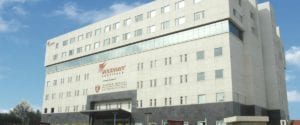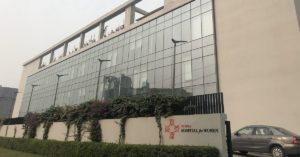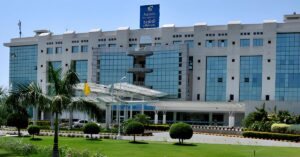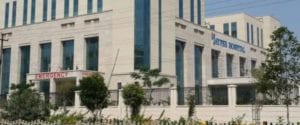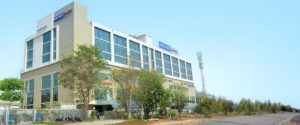Best Doctors in India for Face Lift
Best Hospitals in India for Face Lift
- City: Mumbai, India
Hospital Highlights:
- Fortis Hiranandani hospital was established in 2007.
- The hospital is an advanced tertiary care, multi-specialty hospital equipped with 149 beds.
- The hospital is equipped with a super ICU to provide emergency medical care to critically ill patients.
- The hospital is NABH accredited.
- The critical care facility in the hospital is augmented with the state-of-the-art facilities that facilitate speedier diagnosis and efficient monitoring.
- The hospital provides specialty medical services in cardiology, orthopedic science, pediatric science, neurology, diabetic care, urology, nephrology, ENT, obstetrics, gynecology, cosmetic surgery, bariatric surgery, neuro and spine care.
- City: Gurugram, India
Hospital Highlights:
- W Pratiksha Hospital, Gurugram, is one of the best hospitals in the NCR region. It is also a top hospital in India for IVF. Since its inception, the hospital has performed over 5500 successful IVFs. The hospital also specializes in gynecology.
- With over 20 years of experience in providing quality healthcare, the hospital is known as one of the most trusted and valued health providers in India.
- Equipped with world-class medical facilities and advanced technology, the hospital’s doctors and clinicians also have a track record of delivering excellent results. The hospital is also known for focusing on preventive well-being as much as on curative treatment.
- The hospital has earned the trust of its patients, by providing the best available treatments at affordable costs.
- City: Gurugram, India
Hospital Highlights:
- Paras hospital was established in 2006 and is the 250 bedded flagship hospital of Paras Healthcare.
- The is supported by a team of doctors of international and national repute.
- The hospital is NABH accredited and also the first hospital in the region to have a NABL accredited laboratory.
- The hospital provides specialty medical services in around 55 departments including Neurosciences, Joint Replacement, Mother & Child Care, Minimal Invasive Surgery, Gynecology and Obstetrics, Ophthalmology, Dermatology, Endocrinology, Rheumatology, Cosmetic and Plastic surgery.
- The hospital is equipped with state-of-the-art technologies.
- City: Kolkata, India
Hospital Highlights:
- Fortis Hospital, Anandapur, Kolkata is a world-class super-speciality equipped with the latest technologies in the medical world.
- The hospital is NABH accredited.
- This state-of-the-art facility specializes in cardiology and cardiac surgery, urology, nephrology, neurosciences, orthopaedics, digestive care, emergency care and critical care.
- The hospital, governed by integrated Building Management System (IBMS), has a pneumatic chute system, for quick vertical and horizontal transportation between floors, facilitating speedy transfer of patient specimens, documents, reports, and medicines to the concerned departments.
- The hospital also has a nephrology department with over 28 advanced dialysis units.
- City: Mumbai, India
Hospital Highlights:
- SL Raheja hospital is a 140-bed multi-specialty tertiary care hospital that is being managed by Fortis Healthcare Ltd.
- The hospital is a benchmark in healthcare and medical facilities in the neighborhood of Mahim & the western suburbs.
- L.Raheja Hospital, Mahim has one of the most effective ICU and Casualty care services.
- The hospital provides specialty medical services in Cardiology, Oncology, Neurology, Orthopedics, Mother & Child Care, and in Diabetes.
- City: Mumbai, India
Hospital Highlights:
- Wockhardt Hospitals were established in the year 1973, originally called First Hospitals and Heart Institute.
- Wockhardt Hospitals are super specialty health care networks in India, nurtured by Wockhardt Ltd, India’s 5th largest Pharmaceutical and Healthcare company.
- Wockhardt Hospitals is associated with Partners Harvard Medical International, an international arm of Harvard Medical School, USA.
- Wockhardt Heart Hospital performed India’s first endoscopic heart surgery.
- The hospital has a state-of-the-art infrastructure equipped with the latest technologies and modern equipment.
- It has special Centers of Excellence dedicated to the major specialties to provide hassle-free and high-quality clinical care.
- City: Gurugram, India
Hospital Highlights:
- The CK Birla Hospital in Gurugram is a NABH-accredited multi-specialty hospital.
- The hospital strives to increase the quality of healthcare by focusing on UK NHS nurse and midwife training requirements. Policies and practices derived from the National Institute for Health and Treatment Excellence (NICE) recommendations in the United Kingdom ensuring that a strong focus on safety, high-quality clinical care, and sanitation is maintained.
- The hospital’s cutting-edge technology and facilities allow for real-time communication and seamless collaboration among caregivers, ensuring accuracy and the best possible results. Those with foreign experience and accreditations make up part of the hospital’s team of clinicians.
- City: Ahmedabad
Hospital Highlights:
- As a member of the Apollo Hospitals Group, Apollo Hospitals International Limited, Ahmedabad is one of the most popular and sought-after medical facilities in Gujarat.
- Through its 6 Centres of Excellence and various affiliated branches, which cover all specialties and subspecialties, the hospital provides the most advanced clinical services.
- Since its inception in 2003, the hospital has been providing each patient with the most up-to-date medical equipment and state-of-the-art technology.
- With more than 150 successful organ transplants, including liver and renal transplants, the facility has been able to build a strong and extensive organ transplant program.
- In addition to performing 600 surgeries and caring for over 1800 patients on an IP basis, the hospital sees more than 18,000 patients on average in the outpatient department.
- With one of the biggest cardiology teams in the area, the hospital provides state-of-the-art regional care treatment in Cardiac Sciences.
- Additionally, the hospital offers a broad range of Neuro Interventional techniques to help stroke patients recover more quickly.
- City: Noida, India
Hospital Highlights:
- Jaypee Hospital is the flagship hospital of the Jaypee Group.
- This hospital has commissioned 525 beds in the first phase and has been planned and designed as a 1200 bedded multi-specialty facility.
- It holds the accreditation of the NABH and NABL.
- The hospital has state-of-the-art infrastructure equipped with the latest technologies and modern equipment like 64 Slice PET CT, Dual Head 6 Slice SPECT CT, Gamma Camera, and Da Vinci Robotic Surgery for comprehensive robotic surgical solutions.
- It has special Centers dedicated to the major specialties to provide hassle-free and high-quality clinical care.
- City: Mumbai, India
Hospital Highlights:
- Reliance Hospital is one of the best super-specialty care hospitals in Navi Mumbai.
- The main purpose of this hospital is to become a trustworthy place for the best health and hope for society. The hospital is well connected to the suburbs of Mumbai and Navi Mumbai.
- The hospital has various specialty departments, viz., Accident & Emergency, Anesthesiology, Dental Services, Dermatology, Diabetology, Dietetics Nutrition, Endocrinology, ENT, Gastroenterology, General Surgery, Gynaecology And Obstetrics, Hepato Pancreato Biliary Surgery, Infectious Disease, Internal Medicine, Interventional Radiology, Laboratory Medicine, Minimal Access Laparoscopic Surgery, Nephrology, Neurosciences, Opthalmology, Orthopaedics, Paediatrics, Pain Management Palliative Care, Physical Medicine Rehabilitation, Plastic And Reconstructive Surgery, Psychiatry, Pulmonary Medicine, Radiology, Rheumatology, Transplant, Urology Andrology, Vascular Surgery
FACE LIFT
Face-lift also termed as rhytidectomy is a cosmetic surgical procedure that can make your face have a younger appearance by tightening the facial tissues. This procedure reduces the sagging or folds of skin on the cheeks and jawline and any other such changes in your face that can occur with age.
Neck lift, termed as platysmaplasty, is usually done as part of this procedure, as it helps to reduce fat deposits as well as sagging skins on the neck.
It is to be noted that a face-lift will not decrease fine creases, damage from sun exposure or any kind of wrinkles in your skin.
Purpose
As we get older, the appearance as well as the shape of our face is altered due to age-related changes. The skin eventually loses its elasticity and becomes loose. Fat deposits can decrease in some areas of the face and increase in others. A face-lift can help you reduce age-related changes in your face, which includes:
- Sagging appearance of your cheeks
- Deepening of the fold of the skin from the side of the nose to the corner of the mouth
- Excess skin at the lower jawline
- Sagging skin and excess fat in your neck (if a neck lift is included in your procedure).
Preparation
Preparing for a facelift is similar to preparing for any kind of surgery. Before the surgery, your doctor may ask you for presurgical evaluation and might ask you to stop taking certain medications or adjust the dosage before your procedure.
Your doctor can ask also you to:
- Stop smoking.
- Discontinue using aspirin, any kind of anti-inflammatory pain relievers, as well as any herbal supplements which can reduce the risk of bleeding and bruising
- Apply specific products to your face before your procedure
Your plastic surgeon will also need to take photos of your face from multiple angles as well as close-up photos of some features. The surgeon will then examine your bone structure as well, the shape of your face, fat distribution and skin quality, as it will help him/her determine the best options for your face-lift. You will also need to talk to him/her regarding your expectations for the outcomes of the procedure.
The procedure can take place at a surgical center or at the hospital, and you will need someone to drive you to and from the center as it is likely that you will be under general anesthesia. It’s better if you can arrange for someone to stay with you for a night or two after the procedure as well.
Procedure
Generally, a face-lift involves elevating the skin and tightening the underlying tissues and muscles. Fat located in your neck and face may be removed, sculpted or redistributed. Then the facial skin is re-draped over the newly repositioned contours of your face and any excess skin is removed, after which the wound is stitched or taped closed.
The incisions for the procedure will depend on the techniques that will be used as well as the patient’s preferences. Options include:
Traditional face-lift incision
A traditional face-lift incision begins at your temples in the hairline and continues down and around the front of your ears and ends behind your ears in the lower scalp. An incision might be created under your chin as this can improve the appearance of your neck.
Limited incision
Limited incision is a shorter incision that starts in your hairline just above your ear and wraps around the front of your ear. However, it does not extend all the way into your lower scalp.
Neck lift incision
Neck lift incision begins in front of your earlobe and continues around your ear into the lower scalp. A small incision is created under the chin as well.
A face-lift should take between two to four hours. However, if other procedures are included, it should take longer.
After the procedure
After a face-lift, you can experience the following:
- Mild to moderate pain
- Swelling
- Bruising
- Numbness
- Drainage from the incisions
Contact your doctor soon if you have:
- Severe pain on one side of your face or neck after around 24 hours of surgery
- Shortness of breath
- Irregular heartbeats
- Chest pain
Your incisions might be covered with the help of bandages that can provide gentle pressure for minimizing bruising and swelling. A small tube may be placed under your skin behind one or both of your ears for draining any excess fluid or blood.
- Following your surgery, for a few days:
- You need to keep your head elevated after the surgery
- Take pain medication that your doctor recommends
- Apply a few cool packs to your face as it can ease pain and reduce swelling
You will have multiple follow-up appointments scheduled during the next two months after your surgery. They will include the following:
- The day after your surgery, your surgeon may need to remove your drainage tube and apply antibiotic ointment to your incisions as well as place new bandages on your face.
- Around two to three days after the face-lift, you might be able to switch from wearing bandages to wearing an elasticized facial sling.
- Around one week after your surgery, your doctor will be removing your stitches and assess the wound.
- Subsequent visits may be scheduled for monitoring your progress.
Recovery
Self-care at home is important for the first three weeks after the face-lift as this will aid your recovery and minimize the risk of complications:
- Follow instructions related to wound care as directed by your surgeon
- Follow instructions regarding when you can start using shampoo, soaps and of what kind
- Do not pick at crusting scabs that might develop on your wound
- It is better to wear clothes that fasten in the front rather than clothes that require to be pulled over the head
- Avoid too much pressure or motion on and around your incisions
- Avoid sports or any kind of vigorous or aerobic activity
- Avoid using any makeup
- Avoid direct sun exposure to the incision for at least three weeks and use a sunscreen thereafter
- Avoid coloring and bleaching your hair for at least six weeks after the procedure
During your recovery period after the face-lift, you can style your hair to hide any remaining signs of the incision. You can choose to delay attending any major social events for a couple of months as well.
It is important to remember that the results of a face-lift are not permanent. With age, the facial skin can begin to droop again, though generally, a face-lift should last around ten years.
Risks
Like any other medical procedure, there are few risks to a facelift, which includes:
- bleeding
- infection
- blood clots
- anesthesia risks
- cardiac events
- pain or scarring
- hair loss at the incision sites
- problems with wound healing
- prolonged swelling






